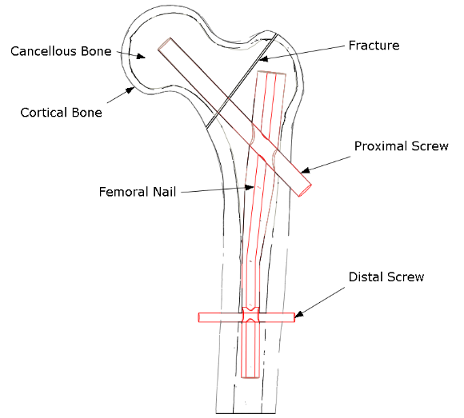German Congress of Orthopaedics and Traumatology (DKOU 2025)
Deutscher Kongress für Orthopädie und Unfallchirurgie 2025 (DKOU 2025)
Distal screw in femoral nails for neck fractures fixation: Is it always necessary? A finite element analysis
2Université Libre de Bruxelles – BEAMS Department, Brussels, Belgien
3Orthopaedics and traumatology department, Guglielmo da Saliceto Hospital, AUSL Piacenza, Piacenza, Italien
4University of Parma, Parma, Italien
Text
Objectives and questions: Proximal femoral fractures are common in elderly and osteoporotic patients. The gamma nail system is widely used for fixation [1], but the necessity of the distal locking screw in stable fractures remains debated [2]: it ensures stability, but it can lead to increased stress concentration. This study aims to biomechanically evaluate the impact of distal screw omission in two-parts fractures, at different follow-up situations.
Material and methods: The analysis was conducted using the Finite Element Method (FEM). Geometries of a healthy femur were obtained from CT scans of a Sawbone, and a model of a gamma nail was designed, based on the commercially available one used by the surgeons.
Five models were analyzed: a healthy femur (as reference) and four implanted configurations, with or without the distal screw, at two follow-up stages – immediate post-op (with a simulated two-part fracture) and complete bone healing. Material properties for bone and implant were sourced from the literature. A 2400 N load, simulating walking, was applied along the mechanical axis. Bone stresses and micromotions were assessed in three regions of interest: (1) fracture site, (2) metaphysis, and (3) femoral shaft, and compared to the healthy model.
Results: Omitting the distal screw reduced stress concentrations in the distal femur, especially in fracture cases. However, it increased peak stresses in the proximal femur, indicating potential higher micromotion at the fracture site. Distal locking enhanced stability but caused greater stress near the locking hole.
Discussion and conclusions: The findings suggest that omitting the distal screw in two-part fractures may reduce stress-related complications in the femoral shaft and simplify surgery. This biomechanical advantage, aligning with previous clinical results [2], is fracture-pattern dependent: screw-free fixation may be valid for stable fractures with good alignment, reducing the risk of fractures near the screw hole, but distal locking remains beneficial for less stable cases to ensure mechanical integrity.
Figure 1 [Fig. 1]
Figure 1: Section of the femur model, in the configuration involving the presence of the fracture and a gamma nail implant with distal screw.
Table 1 [Tab. 1]
Table 1: Average Von Mises Stress [MPa] from the 3 ROIs in the different configurations.
References
[1] Valverde JA, Alonso MG, Porro JG, Rueda D, Larrauri PM, Soler JJ. Use of the gamma nail in the treatment of fractures of the proximal femur. 1998. J Orthop Trauma. 2003 Sep;17(8 Suppl):S51-6. DOI: 10.1097/00005131-200309001-00010[2] Quattrini F, Ortolani A, Ciatti C, Puma Pagliarello C, Martucci A, Gurrieri L, Stallone S, Melucci G, Domenico T, Maniscalco P. Static vs dinamic short nail in pertrochanteric fractures: experience of two center in Northern Italy. Acta Biomed. 2021 Jul 26;92(S3):e2021021. DOI: 10.23750/abm.v92iS3.11745




